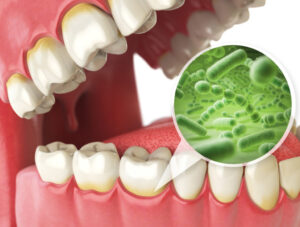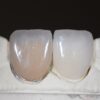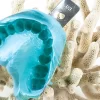CAMBRA
Caries risk assessment and management for the prosthodontic patient
Featherstone et al 2011

- CAMBRA stands for Caries Management by Risk Assessment
- Validated through a 3-year randomized clinical trial at the University of California, San Francisco
- The patient referred for prosthodontic care is often at high risk for caries.
- Prosthodontic procedures often leave patients at risk for caries.
- Pjetursson et al showed caries to be the second most common complication over a 5- year period, after
abutment tooth devitalization. - Goodacre 0.4% caries in single-crown restorations
Caries risk in the prosthodontic patient is high
- Tooth loss
- Existing restorations
- Root exposure
- Age-associated comorbidities
- Diminished skill in completing
oral hygiene procedures.
Acidogenic biofilm bacteria responsible for caries
- Lactobacillus species
- Streptococcus mutans
- Streptococcus sobrinus
Enamel and dentin are tissues made up of crystals called a carbonated hydroxyapitite = calcium
phosphate . Carbonate responsible to make mineral more soluble
Remineralization of the tooth is possible if acid from the bacteria in the biofilm is buffered by
saliva, allowing calcium and phosphate to flow back into the tooth to form new mineral on the partially dissolved subsurface crystals
Fluoride
-
- Primary mechanisms of action are topical by inhibiting demineralization
- Enhancing remineralization
- High concentrations, inhibit the metabolism of bacteria.
Caries removal and placement of definitive restorations do not decrease the potential for future
caries. Featherstone found that the bacteria before and after are the same
Removing active caries and completing prosthodontic work does not reduce the patient’s risk for future
caries
Fluoride:
Toothpaste
- Reduce 35%
- Less than 600 ppm low benefit
- 1000 ppm recommended twice a day
Varnish
-
- Longed fluoride release, easy
application, and lack of need for patient compliance - With toothpaste added only
benefit of 10% - Not using toothpaste but only
varnish caries reduce 30% - 3 times annually
- Longed fluoride release, easy
Chlorhexidine digluconate
- The CHX mechanism of action is a strong base with cationic properties. The cationic molecules bind to the negatively charged bacteria cell walls (disrupting the osmotic balance) and weaken the bacteria over time.
- Strong support for chlorhexidine as an antimicrobial in suppressing S. mutans but found it less effective in suppressing Lactobacilli.
- Because the fluoride ion is negative and the chlorhexidine ion is positive, there is some interaction between the two, and they should be used at least 1 hour apart to allow each to interact with the plaque and not compete with the other.
- The most common side effects of chlorhexidine rinses are staining of teeth and/or prostheses and an adverse impact on taste.
- 10 ml of a 0.12% rinse for 1
minute at night at least 1 hour after brushing with fluoridated toothpaste
and after removing any prosthesis 7 days a month.
Xylitol
- Benefits:
- ّincreasing salivary flow
- Raising pH
- Decrease colony counts of S. mutans,
- Decreasing the adherence of S. mutans to the tooth structure,
- Enhancing remineralization of
subsurface enamel lesions.
- Xylitol is a so-called sugar alcohol that also has direct anti-cariogenic effects by decreasing viability and decreasing acid release from S. mutans.
- Reduce 58% than non-chewing gum Simons
- Potential adverse effects of xylitol include minor gastrointestinal irritation
- Twice daily for 15 minutes with a total xylitol dose of 7 to 10 g per day
- Xylitol + chlorohexidine reduce 91%
Amorphous calcium phosphate
- Remineralization of subsurface enamel lesions by diffusion of the ions back into the tooth structure
- Application follows the use of fluoridated toothpaste twice a day using a cotton swab, a finger, or a custom tray.
Stimulation of salivary flow
- Salivary functions
- Providing buffering capacity to
maintain a neutral oral pH - Carrying calcium, phosphate,
and fluoride ions for potential remineralization of tooth structure - Containing histidine-rich
peptides (the histatins) that are fungicidal and antibacterial - Providing enzymes that aid in
lubricating and digesting food and mucins that lubricate the mouth.
- Providing buffering capacity to
- Can be altered and/or diminished by
- Including medication-induced xerostomia
- Uncontrolled diabetes
- Head and neck radiation therapy
- Autoimmune disorders such as
Sjogren’s syndrome.
- Clinical findings that may result in diminished salivary flow
- Recurrent dental caries
- Oral yeast infections
- Inflamed soft tissues
- Chapped or cracked lips and
tongue, - Swollen salivary glands
- Difficulty swallowing or
chewing.
- Management of xerostomia
- Often palliative.
- A low sugar diet
- Daily use of topical fluoride
- Antimicrobial mouth rinses
- Xylitol gum,
- Avoiding mouthwashes with alcohol
- Sugar-free gum or candy.
- Oral moisturizers, lubricants, artificial saliva (mixture of ions, cellulose derivatives, and flavoring
agents ), and humidifiers at night have been reported to provide symptomatic relief of dry mouth.
- Food and Drug Administration approved prescription sialogogues containing pilocarpine and ce- vimeline,
which are parasympathomimetic-stimulating agents; however, these are contraindicated for patients with uncon- trolled asthma, narrow-angle glaucoma, or acute iritis. - Buffering products such as sodium bicarbonate can be used to aid in neutralizing the pH of the oral cavity, which will decrease enamel mineral loss. water that contains two teaspoons of baking soda in 8 oz of water will help hydrate the mouth and neutralize bacterial acids generated in the plaque.
Biotene
- These products contain the enzymes lactoferrin, glucose oxidase, and lactoperoxides.
- The products are intended to mimic natural saliva, but they do not have any buffering ca- pacity or anticaries effects
1% Iodine
- Iodine has been shown to be microbiocidal on Gram-negative bacteria, fungi, my- cobacteria, viruses,
and protozoan by working directly on the microbial cell wall. - Iodine has been shown to be effective in controlling early childhood caries by reducing both S. mu- tans and Lactobacillus in children. Not effective in adult
- The use of iodine as an antimicrobial is not recommended since there is currently little evidence of its effectiveness in adults
Bacterial testing
- The kit includes a two-sided selective media stick that assesses S. mutans on the blue side and Lactobacilli on the green side.
The patient chews a paraffin pellet for 3 to 5 minutes and expectorates all saliva into a measuring cup. The amount of saliva (in milliliters) is measured and divided by the amount of time the pellet was chewed to determine the milliliter per minute of stimulated salivary flow. A flow rate of ≥1.0 ml/min is considered normal. A level of 0.7 ml/min is low, and anything ≤0.5 ml/min is dry, indicating severe salivary gland hypofunction.



